2006 Seat Cordoba AUX
[x] Cancel search: AUXPage 5 of 70
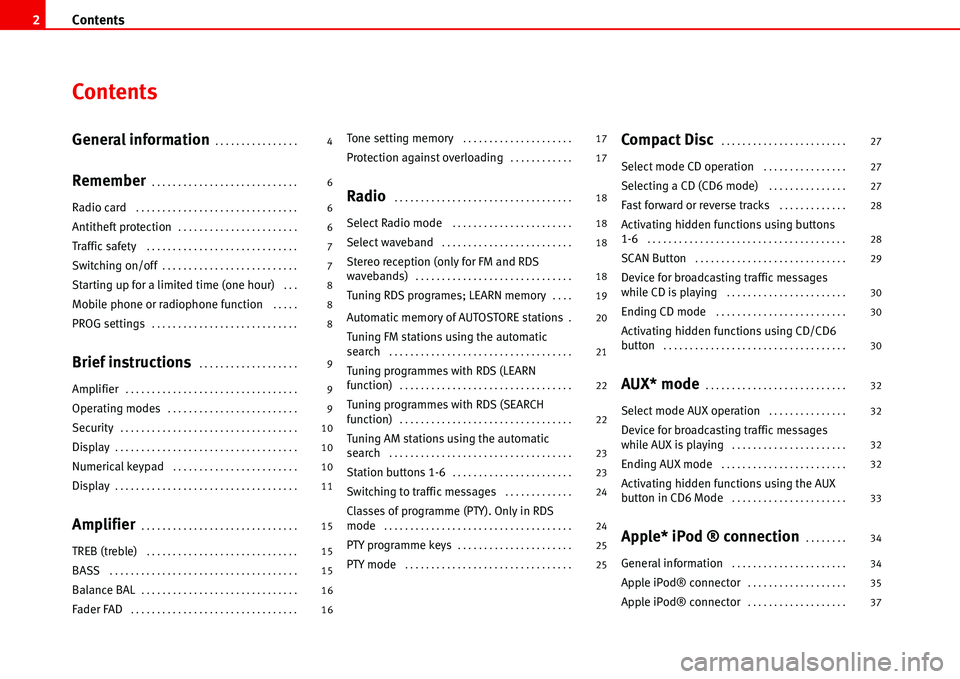
Contents 2
Contents
General information. . . . . . . . . . . . . . . .
Remember. . . . . . . . . . . . . . . . . . . . . . . . . . . .
Radio card . . . . . . . . . . . . . . . . . . . . . . . . . . . . . . .
Antitheft protection. . . . . . . . . . . . . . . . . . . . . . .
Traffic safety . . . . . . . . . . . . . . . . . . . . . . . . . . . . .
Switching on/off. . . . . . . . . . . . . . . . . . . . . . . . . .
Starting up for a limited time (one hour) . . .
Mobile phone or radiophone function . . . . .
PROG settings. . . . . . . . . . . . . . . . . . . . . . . . . . . .
Brief instructions . . . . . . . . . . . . . . . . . . .
Amplifier. . . . . . . . . . . . . . . . . . . . . . . . . . . . . . . . .
Operating modes. . . . . . . . . . . . . . . . . . . . . . . . .
Security. . . . . . . . . . . . . . . . . . . . . . . . . . . . . . . . . .
Display. . . . . . . . . . . . . . . . . . . . . . . . . . . . . . . . . . .
Numerical keypad . . . . . . . . . . . . . . . . . . . . . . . .
Display. . . . . . . . . . . . . . . . . . . . . . . . . . . . . . . . . . .
Amplifier. . . . . . . . . . . . . . . . . . . . . . . . . . . . . .
TREB (treble) . . . . . . . . . . . . . . . . . . . . . . . . . . . . .
BASS . . . . . . . . . . . . . . . . . . . . . . . . . . . . . . . . . . . .
Balance BAL. . . . . . . . . . . . . . . . . . . . . . . . . . . . . .
Fader FAD . . . . . . . . . . . . . . . . . . . . . . . . . . . . . . . .
Tone setting memory . . . . . . . . . . . . . . . . . . . . .
Protection against overloading. . . . . . . . . . . .
Radio . . . . . . . . . . . . . . . . . . . . . . . . . . . . . . . . . .
Select Radio mode . . . . . . . . . . . . . . . . . . . . . . .
Select waveband . . . . . . . . . . . . . . . . . . . . . . . . .
Stereo reception (only for FM and RDS
wavebands). . . . . . . . . . . . . . . . . . . . . . . . . . . . . .
Tuning RDS programes; LEARN memory. . . .
Automatic memory of AUTOSTORE stations.
Tuning FM stations using the automatic
search . . . . . . . . . . . . . . . . . . . . . . . . . . . . . . . . . . .
Tuning programmes with RDS (LEARN
function). . . . . . . . . . . . . . . . . . . . . . . . . . . . . . . . .
Tuning programmes with RDS (SEARCH
function). . . . . . . . . . . . . . . . . . . . . . . . . . . . . . . . .
Tuning AM stations using the automatic
search . . . . . . . . . . . . . . . . . . . . . . . . . . . . . . . . . . .
Station buttons 1-6. . . . . . . . . . . . . . . . . . . . . . .
Switching to traffic messages . . . . . . . . . . . . .
Classes of programme (PTY). Only in RDS
mode . . . . . . . . . . . . . . . . . . . . . . . . . . . . . . . . . . . .
PTY programme keys. . . . . . . . . . . . . . . . . . . . . .
PTY mode . . . . . . . . . . . . . . . . . . . . . . . . . . . . . . . .
Compact Disc . . . . . . . . . . . . . . . . . . . . . . . .
Select mode CD operation . . . . . . . . . . . . . . . .
Selecting a CD (CD6 mode) . . . . . . . . . . . . . . .
Fast forward or reverse tracks . . . . . . . . . . . . .
Activating hidden functions using buttons
1-6 . . . . . . . . . . . . . . . . . . . . . . . . . . . . . . . . . . . . . .
SCAN Button . . . . . . . . . . . . . . . . . . . . . . . . . . . . .
Device for broadcasting traffic messages
while CD is playing . . . . . . . . . . . . . . . . . . . . . . .
Ending CD mode . . . . . . . . . . . . . . . . . . . . . . . . .
Activating hidden functions using CD/CD6
button . . . . . . . . . . . . . . . . . . . . . . . . . . . . . . . . . . .
AUX* mode. . . . . . . . . . . . . . . . . . . . . . . . . . .
Select mode AUX operation . . . . . . . . . . . . . . .
Device for broadcasting traffic messages
while AUX is playing . . . . . . . . . . . . . . . . . . . . . .
Ending AUX mode . . . . . . . . . . . . . . . . . . . . . . . .
Activating hidden functions using the AUX
button in CD6 Mode . . . . . . . . . . . . . . . . . . . . . .
Apple* iPod ® connection. . . . . . . .
General information . . . . . . . . . . . . . . . . . . . . . .
Apple iPod® connector. . . . . . . . . . . . . . . . . . .
Apple iPod® connector. . . . . . . . . . . . . . . . . . . 4
6
6
6
7
7
8
8
8
9
9
9
10
10
10
11
15
15
15
16
1617
17
18
18
18
18
19
20
21
22
22
23
23
24
24
25
2527
27
27
28
28
29
30
30
30
32
32
32
32
33
34
34
35
37
Page 12 of 70
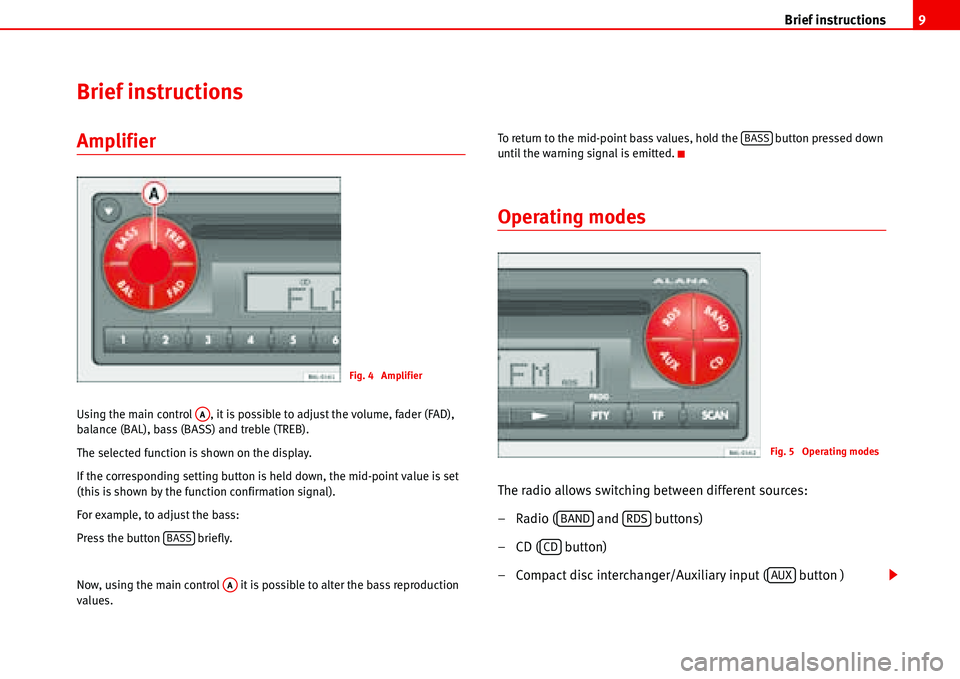
Brief instructions9
Brief instructions
Amplifier
Using the main control , it is possible to adjust the volume, fader (FAD),
balance (BAL), bass (BASS) and treble (TREB).
The selected function is shown on the display.
If the corresponding setting button is held down, the mid-point value is set
(this is shown by the function confirmation signal).
For example, to adjust the bass:
Press the button briefly.
Now, using the main control it is possible to alter the bass reproduction
values.To return to the mid-point bass values, hold the button pressed down
until the warning signal is emitted.
Operating modes
The radio allows switching between different sources:
– Radio ( and buttons)
– CD ( button)
– Compact disc interchanger/Auxiliary input ( button )
Fig. 4 Amplifier
AA
BASS
AA
BASS
Fig. 5 Operating modes
BANDRDS
CD
AUX
Page 13 of 70

Brief instructions 10
If there is a compact disc interchanger or Auxiliary device connected to the car
radio and a CD is inserted, it is possible to switch directly between these two
sound sources using the keys and .
For example:
You are listening to the radio. If the button is pressed briefly the CD will
start to play. By pressing the button the CD stops and the compact disc
interchanger or device is activated.
To return to the radio function, press or .
Security
To prevent your car radio from being stolen, when leaving the
vehicle check:
–the code has been activated
–and you are carrying the removable control panel.
Display
This gives visual information about all the major functions when in radio, CD
or AUX mode.
With the PROG system selected, the functions of the corresponding level are
viewed.
Numerical keypad
The numerical keypad is necessary to store or activate programmes, to adjust
play settings, to search for stations with the PTY code and to activate or deac-
tivate the antitheft protection (Code).
CDAUX
CDAUX
BANDRDS
Fig. 6 Numerical keypad
Page 17 of 70
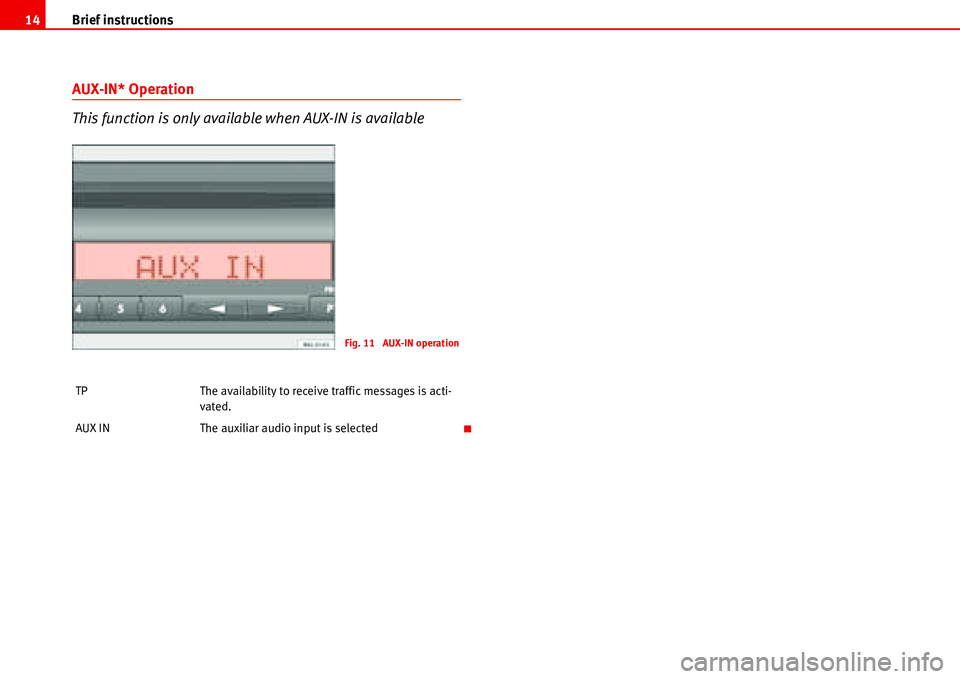
Brief instructions 14
AUX-IN* Operation
This function is only available when AUX-IN is available
TP The availability to receive traffic messages is acti-
vated.
AUX IN The auxiliar audio input is selected
Fig. 11 AUX-IN operation
Page 27 of 70
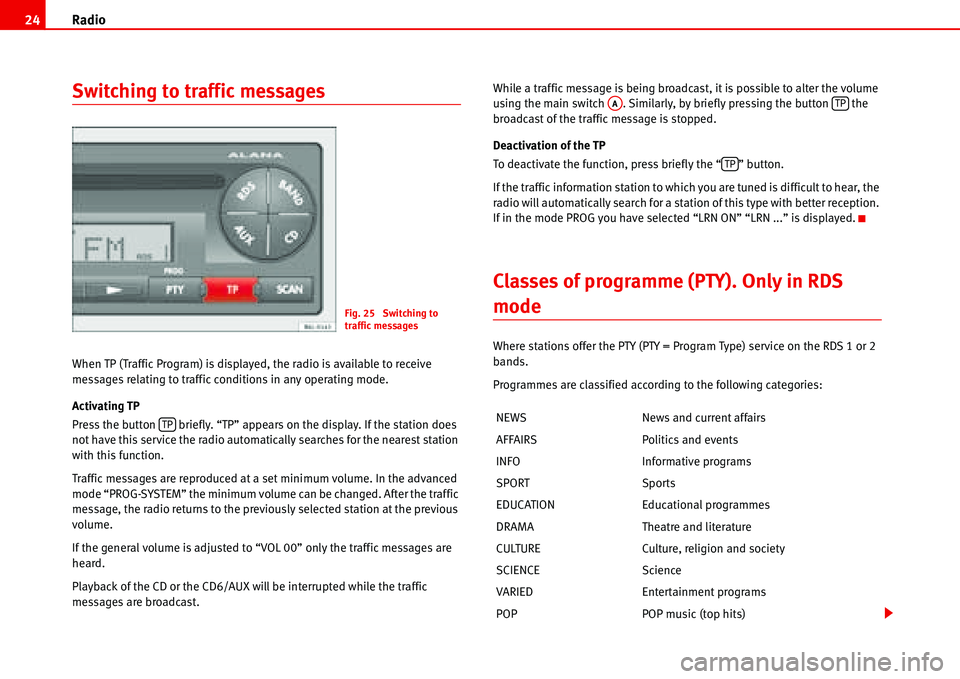
Radio 24
Switching to traffic messages
When TP (Traffic Program) is displayed, the radio is available to receive
messages relating to traffic conditions in any operating mode.
Activating TP
Press the button briefly. “TP” appears on the display. If the station does
not have this service the radio automatically searches for the nearest station
with this function.
Traffic messages are reproduced at a set minimum volume. In the advanced
mode “PROG-SYSTEM” the minimum volume can be changed. After the traffic
message, the radio returns to the previously selected station at the previous
volume.
If the general volume is adjusted to “VOL 00” only the traffic messages are
heard.
Playback of the CD or the CD6/AUX will be interrupted while the traffic
messages are broadcast.While a traffic message is being broadcast, it is possible to alter the volume
using the main switch . Similarly, by briefly pressing the button the
broadcast of the traffic message is stopped.
Deactivation of the TP
To deactivate the function, press briefly the “ ” button.
If the traffic information station to which you are tuned is difficult to hear, the
radio will automatically search for a station of this type with better reception.
If in the mode PROG you have selected “LRN ON” “LRN ...” is displayed.
Classes of programme (PTY). Only in RDS
mode
Where stations offer the PTY (PTY = Program Type) service on the RDS 1 or 2
bands.
Programmes are classified according to the following categories:
Fig. 25 Switching to
traffic messages
TPNEWS News and current affairs
AFFAIRS Politics and events
INFO Informative programs
SPORT Sports
EDUCATION Educational programmes
DRAMA Theatre and literature
CULTURE Culture, religion and society
SCIENCE Science
VARIED Entertainment programs
POP POP music (top hits)
AATP
TP
Page 35 of 70
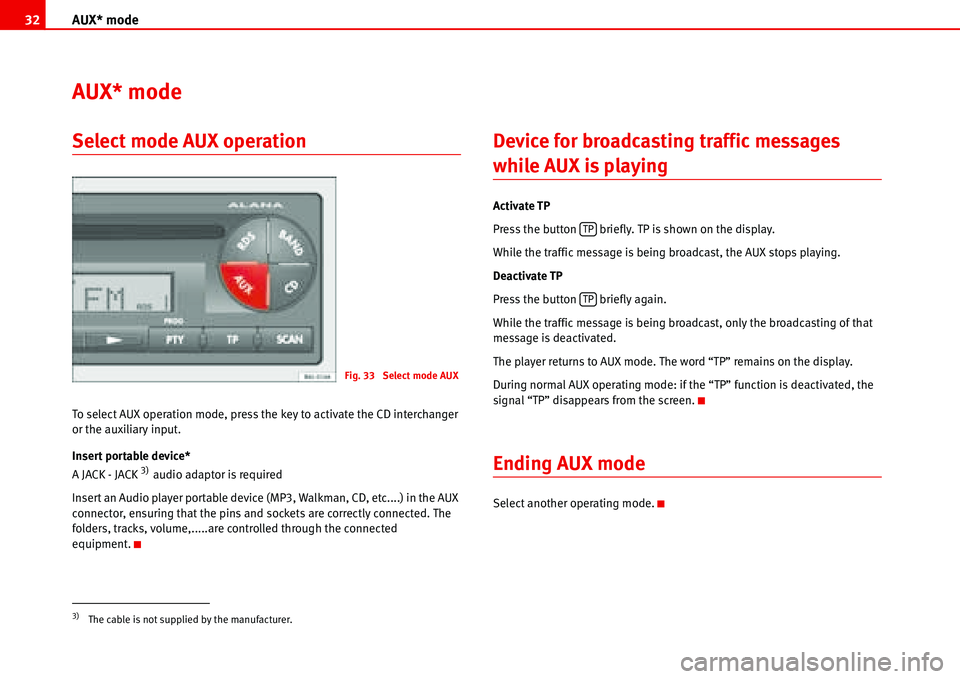
AUX* mode 32
AUX* mode
Select mode AUX operation
To select AUX operation mode, press the key to activate the CD interchanger
or the auxiliary input.
Insert portable device*
A JACK - JACK
3) audio adaptor is required
Insert an Audio player portable device (MP3, Walkman, CD, etc....) in the AUX
connector, ensuring that the pins and sockets are correctly connected. The
folders, tracks, volume,.....are controlled through the connected
equipment.
Device for broadcasting traffic messages
while AUX is playing
Activate TP
Press the button briefly. TP is shown on the display.
While the traffic message is being broadcast, the AUX stops playing.
Deactivate TP
Press the button briefly again.
While the traffic message is being broadcast, only the broadcasting of that
message is deactivated.
The player returns to AUX mode. The word “TP” remains on the display.
During normal AUX operating mode: if the “TP” function is deactivated, the
signal “TP” disappears from the screen.
Ending AUX mode
Select another operating mode.
3)The cable is not supplied by the manufacturer.
Fig. 33 Select mode AUX
TP
TP
Page 36 of 70
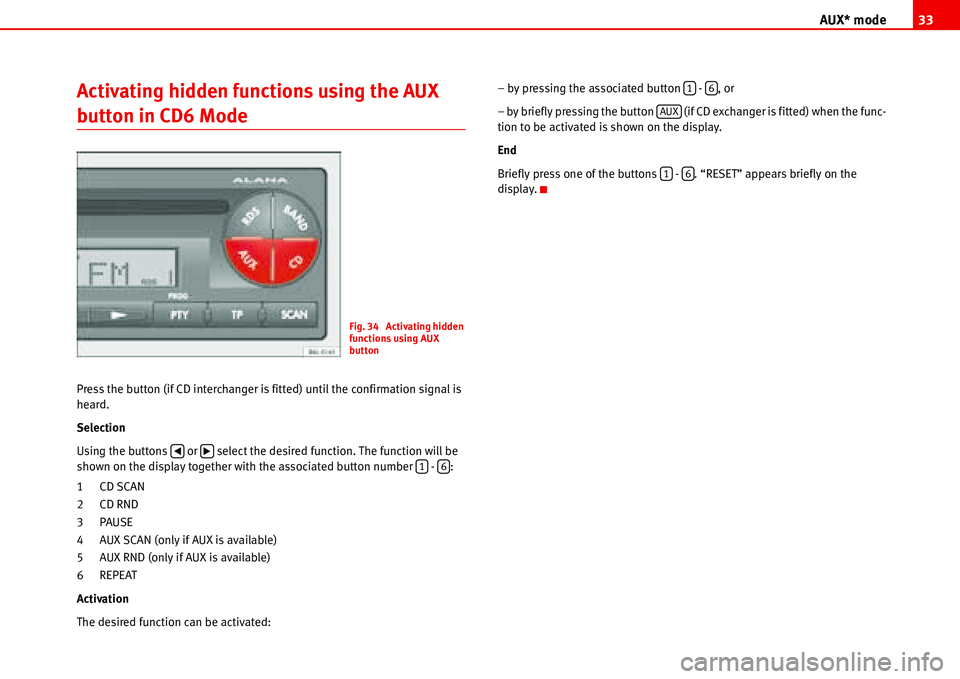
AUX* mode33
Activating hidden functions using the AUX
button in CD6 Mode
Press the button (if CD interchanger is fitted) until the confirmation signal is
heard.
Selection
Using the buttons or select the desired function. The function will be
shown on the display together with the associated button number - :
1CD SCAN
2CD RND
3PAUSE
4 AUX SCAN (only if AUX is available)
5 AUX RND (only if AUX is available)
6 REPEAT
Activation
The desired function can be activated:– by pressing the associated button - , or
– by briefly pressing the button (if CD exchanger is fitted) when the func-
tion to be activated is shown on the display.
End
Briefly press one of the buttons - . “RESET” appears briefly on the
display.
Fig. 34 Activating hidden
functions using AUX
button
�‚�b16
16
AUX
16
Page 66 of 70
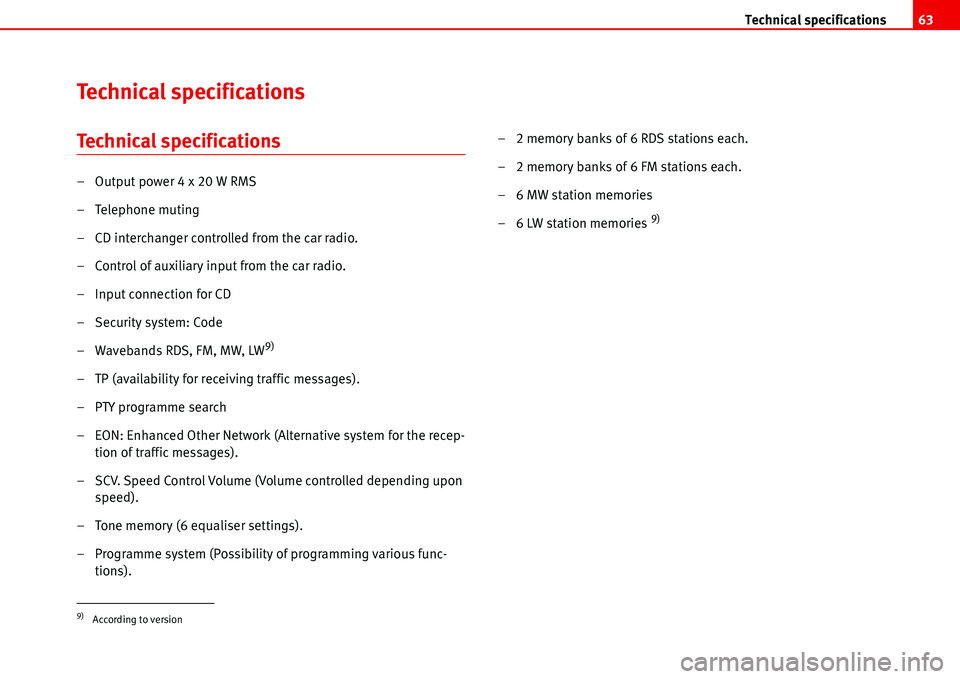
Technical specifications63
Technical specifications
Technical specifications
– Output power 4 x 20 W RMS
– Telephone muting
– CD interchanger controlled from the car radio.
– Control of auxiliary input from the car radio.
– Input connection for CD
– Security system: Code
– Wavebands RDS, FM, MW, LW
9)
– TP (availability for receiving traffic messages).
– PTY programme search
– EON: Enhanced Other Network (Alternative system for the recep-
tion of traffic messages).
– SCV. Speed Control Volume (Volume controlled depending upon
speed).
– Tone memory (6 equaliser settings).
– Programme system (Possibility of programming various func-
tions).– 2 memory banks of 6 RDS stations each.
– 2 memory banks of 6 FM stations each.
– 6 MW station memories
– 6 LW station memories
9)
9)According to version